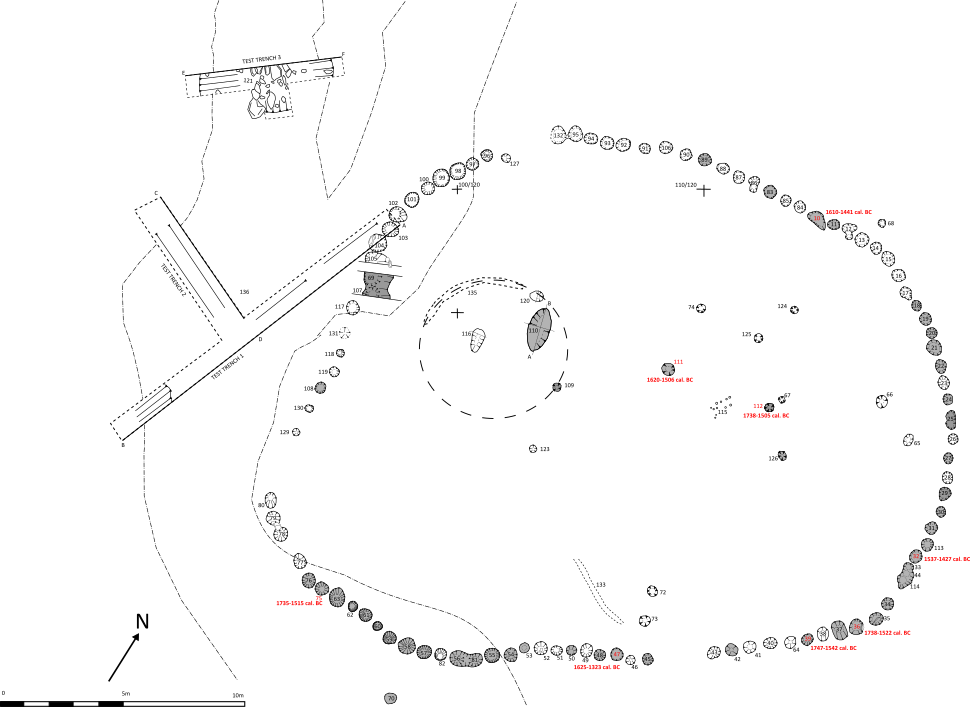2018:876 - GALLIAGH, Ballynagalliagh, Derry
County: Derry
Site name: GALLIAGH, Ballynagalliagh
Sites and Monuments Record No.: N/A
Licence number: AE/17/180
Author: Eoin M Halpin, AHC Ltd.
Author/Organisation Address: 36 Ballywillwill Road, Castlewellan, Co Down BT31 9LF
Site type: Enclosure and Burnt mound
Period/Dating: Bronze Age (2200 BC-801 BC)
ITM: E 642711m, N 921477m
Latitude, Longitude (decimal degrees): 55.038979, -7.331806
The developments at Galliagh Co Londonderry, revealed two sites dating to the Bronze Age. The first, the badly disturbed remains of a burnt mound, consisted of a spread of burnt, heat-cracked stone extending to an area roughly 7m north-south by 10m. The area was crisscrossed by numerous field drains, both stone-filled and lined with plastic piping. Corylus (hazel) charcoal from a relatively undisturbed basal layer produced a radiocarbon date of 2134–1781 cal BC (UBA-43271). Although a number of pieces of wood were recovered at the southern end of the spread, all were from disturbed contexts and no evidence was uncovered for an in situ trough.
Some 90m to the north-west a second, more extensive site was uncovered. In this case it consisted of sub-rectangular, apsidal-ended enclosure, measuring some 20m north-south by 29m and defined by a series of 120 large and well-defined post-holes. The three gaps, one to the south, one to the north and one to the west, all appear to be original and intentional features. Radiocarbon dates indicated a date range in the Middle Bronze Age, the mean dates ranging from 1601 cal. BC to 1484 cal. BC. These dates were supported by the analysis of the pottery assemblage which consisted of 263 sherds, representing an estimated 41 Middle Bronze Age domestic pots, with the date probably centring between c. 1500 and 1400 BC.
While the enclosure post-holes were well defined and well preserved, the same cannot be said for the archaeology in the interior. Significant plough truncation meant that relatively few archaeological features or deposits survived here. There was slight evidence of a circular feature, some 6m in diameter and defined by an ephemeral gully on the north side, with an area of red oxidized soil possibly indicating the position of a hearth feature. Otherwise the internal features were defined by isolated pits and possible post-holes.
The other intriguing aspect of the site was the depositional pattern of the pottery. Sherds from the same vessels were recovered from different post-holes some as much as 25m apart and the condition of the sherds, which exhibited hardly any ware or weathering, suggested to the specialists that the deposition possibly derived from feasting activities in a ritual context.
A similar pattern of selective deposition of pottery was noted from a Middle Bronze Age site in Gransha, Co. Londonderry excavated by Chapple in 2003, AE/02/076 (Chapple 2010). Here, not only was there selective deposition of pottery across the post-holes which defined the site, but the enclosure at Gransha is remarkably similar in plan to that uncovered at Galliagh. Also similar in plan, but slightly smaller, is the Middle Bronze Age site uncovered in the course of the Magherafelt by-pass at Killyfaddy, excavated in 2015, AE/15/055 (McKee et al. 2018).
It seems probable that the sites at Galliagh, Gransha and Killyfaddy are all ritual enclosures dating to the Middle Bronze Age, and together appear to represent a new type-site not previously recognized in the Irish archaeological record.
References
Chapple, R.M. 2010 The Excavation of an Enclosed Middle Bronze Age Cemetery at Gransha, Co. Londonderry, Northern Ireland BAR British Series 521
McKee, J., Jackson, S. and O’Regan, C. 2018 Post-Excavation assessment report on Excavations at Killyfaddy 3, A31 Magherafelt Bypass, Co. Londonderry, Draft Report, Irish Archaeological Consultancy Ltd for WSP on behalf of the Department for Infrastructure.

